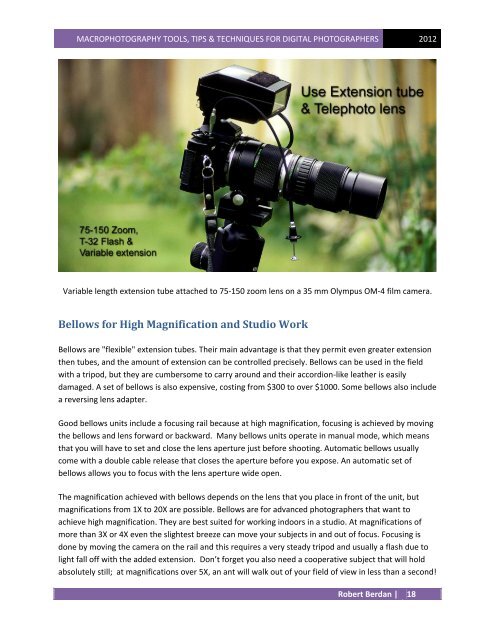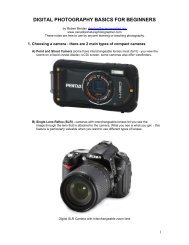Download PDF - The Canadian Nature Photographer
Download PDF - The Canadian Nature Photographer
Download PDF - The Canadian Nature Photographer
You also want an ePaper? Increase the reach of your titles
YUMPU automatically turns print PDFs into web optimized ePapers that Google loves.
MACROPHOTOGRAPHY TOOLS, TIPS & TECHNIQUES FOR DIGITAL PHOTOGRAPHERS 2012<br />
Variable length extension tube attached to 75-150 zoom lens on a 35 mm Olympus OM-4 film camera.<br />
Bellows for High Magnification and Studio Work<br />
Bellows are "flexible" extension tubes. <strong>The</strong>ir main advantage is that they permit even greater extension<br />
then tubes, and the amount of extension can be controlled precisely. Bellows can be used in the field<br />
with a tripod, but they are cumbersome to carry around and their accordion-like leather is easily<br />
damaged. A set of bellows is also expensive, costing from $300 to over $1000. Some bellows also include<br />
a reversing lens adapter.<br />
Good bellows units include a focusing rail because at high magnification, focusing is achieved by moving<br />
the bellows and lens forward or backward. Many bellows units operate in manual mode, which means<br />
that you will have to set and close the lens aperture just before shooting. Automatic bellows usually<br />
come with a double cable release that closes the aperture before you expose. An automatic set of<br />
bellows allows you to focus with the lens aperture wide open.<br />
<strong>The</strong> magnification achieved with bellows depends on the lens that you place in front of the unit, but<br />
magnifications from 1X to 20X are possible. Bellows are for advanced photographers that want to<br />
achieve high magnification. <strong>The</strong>y are best suited for working indoors in a studio. At magnifications of<br />
more than 3X or 4X even the slightest breeze can move your subjects in and out of focus. Focusing is<br />
done by moving the camera on the rail and this requires a very steady tripod and usually a flash due to<br />
light fall off with the added extension. Don’t forget you also need a cooperative subject that will hold<br />
absolutely still; at magnifications over 5X, an ant will walk out of your field of view in less than a second!<br />
Robert Berdan | 18




